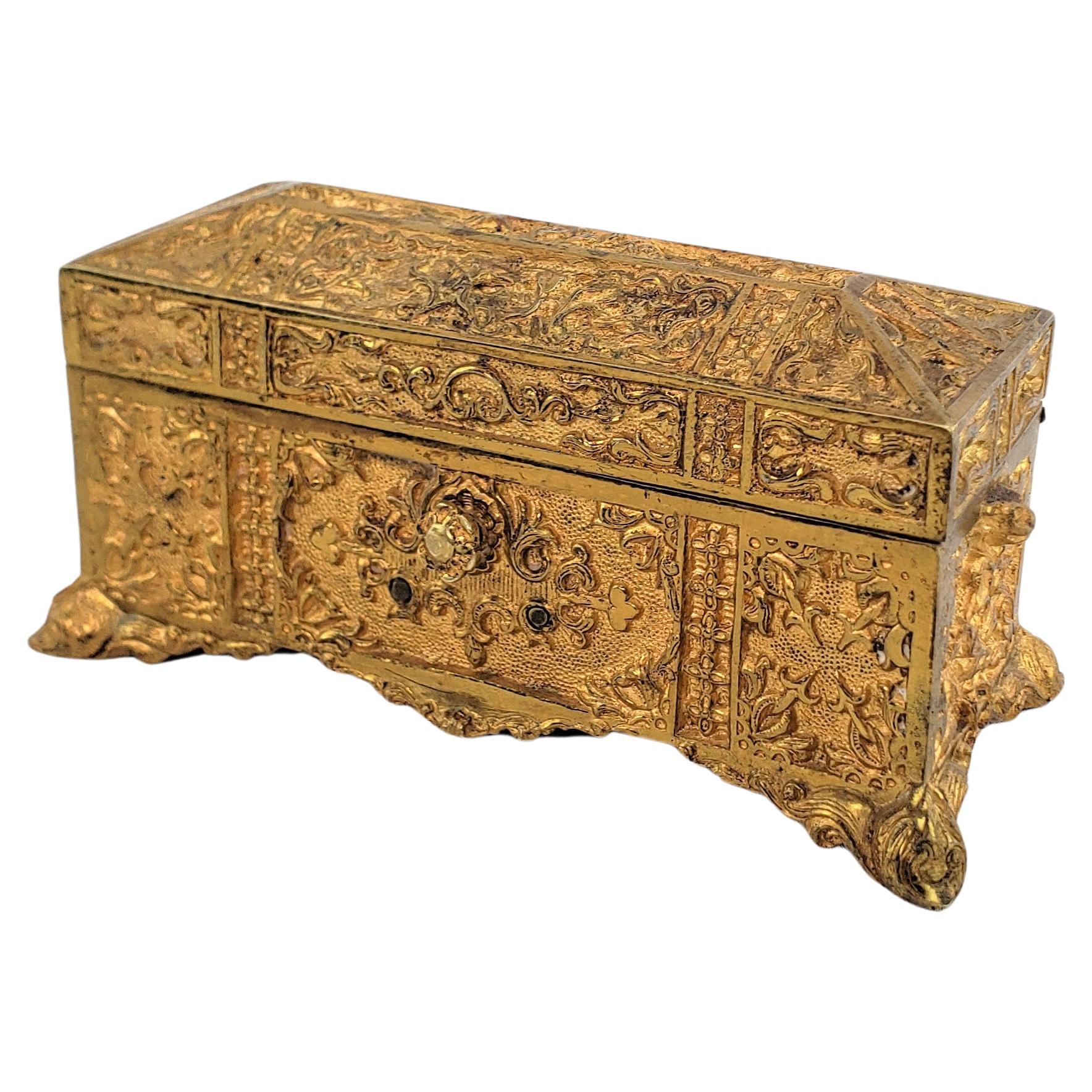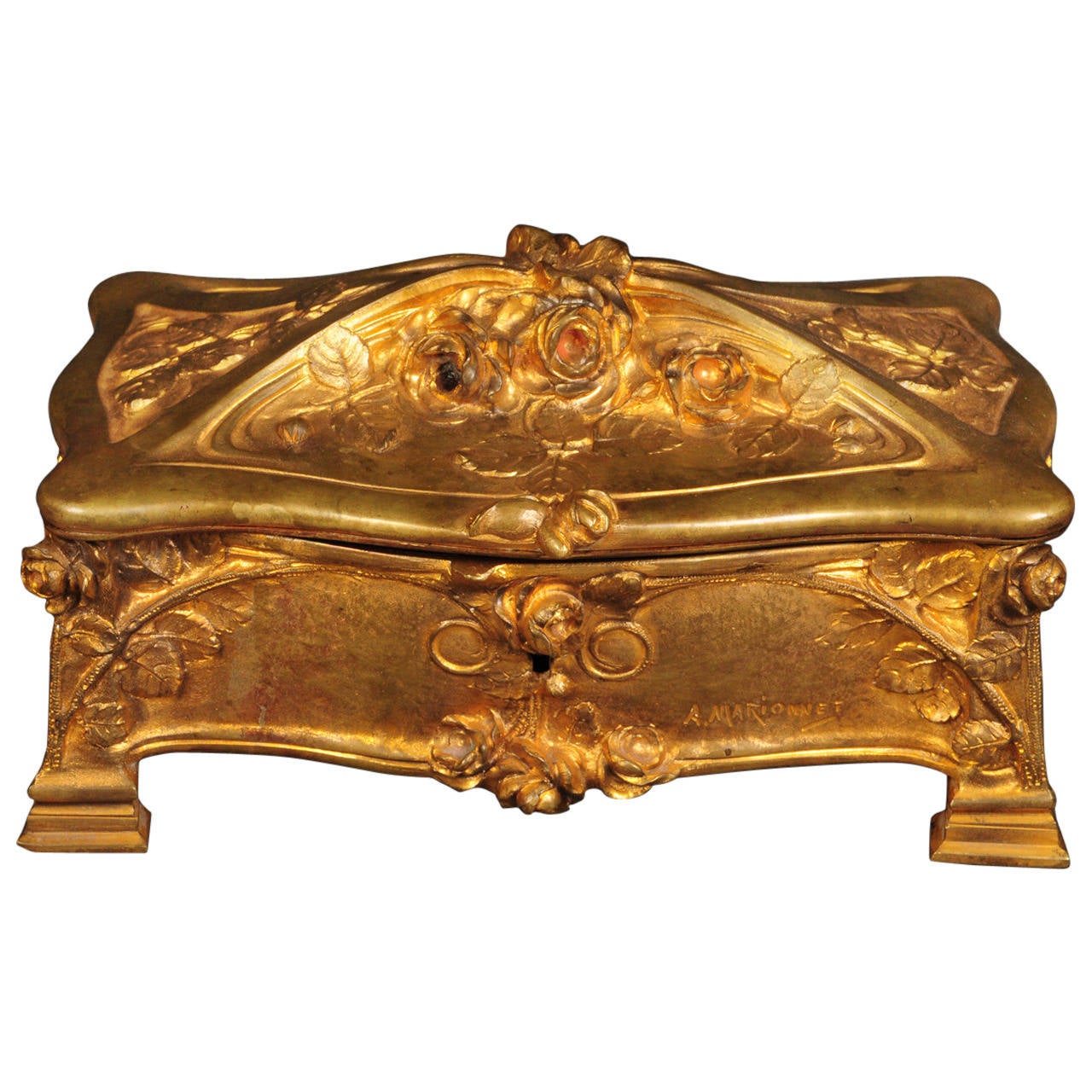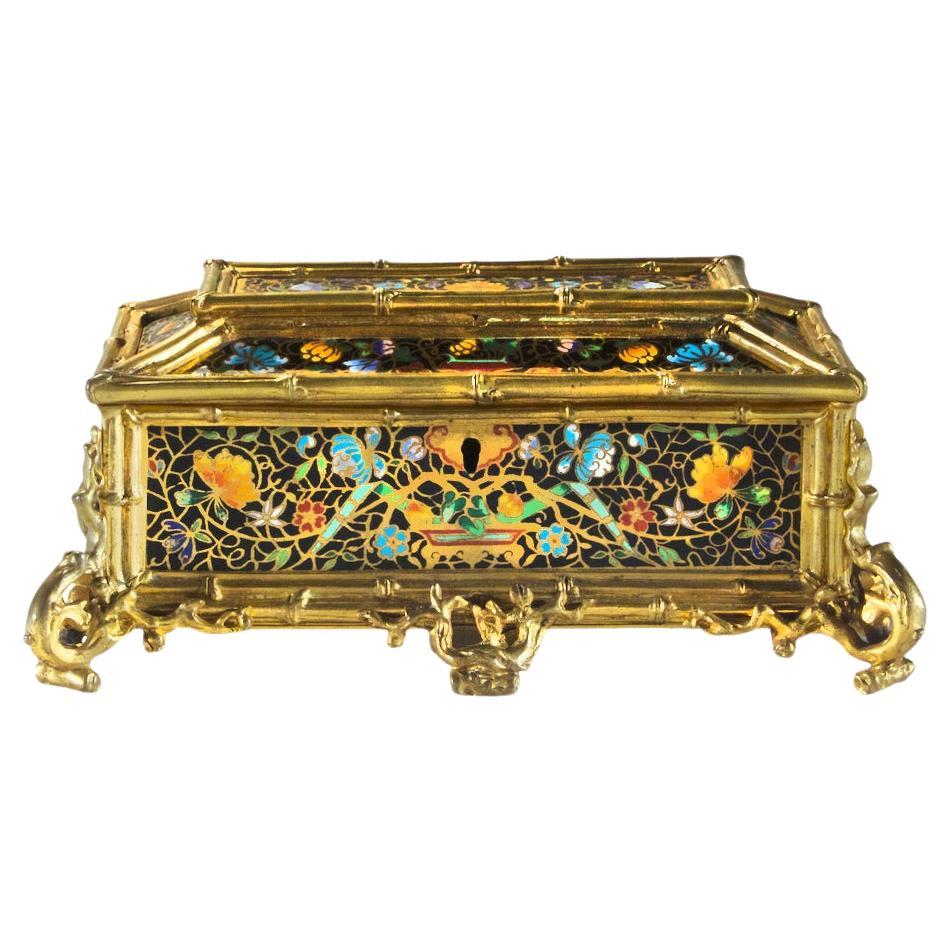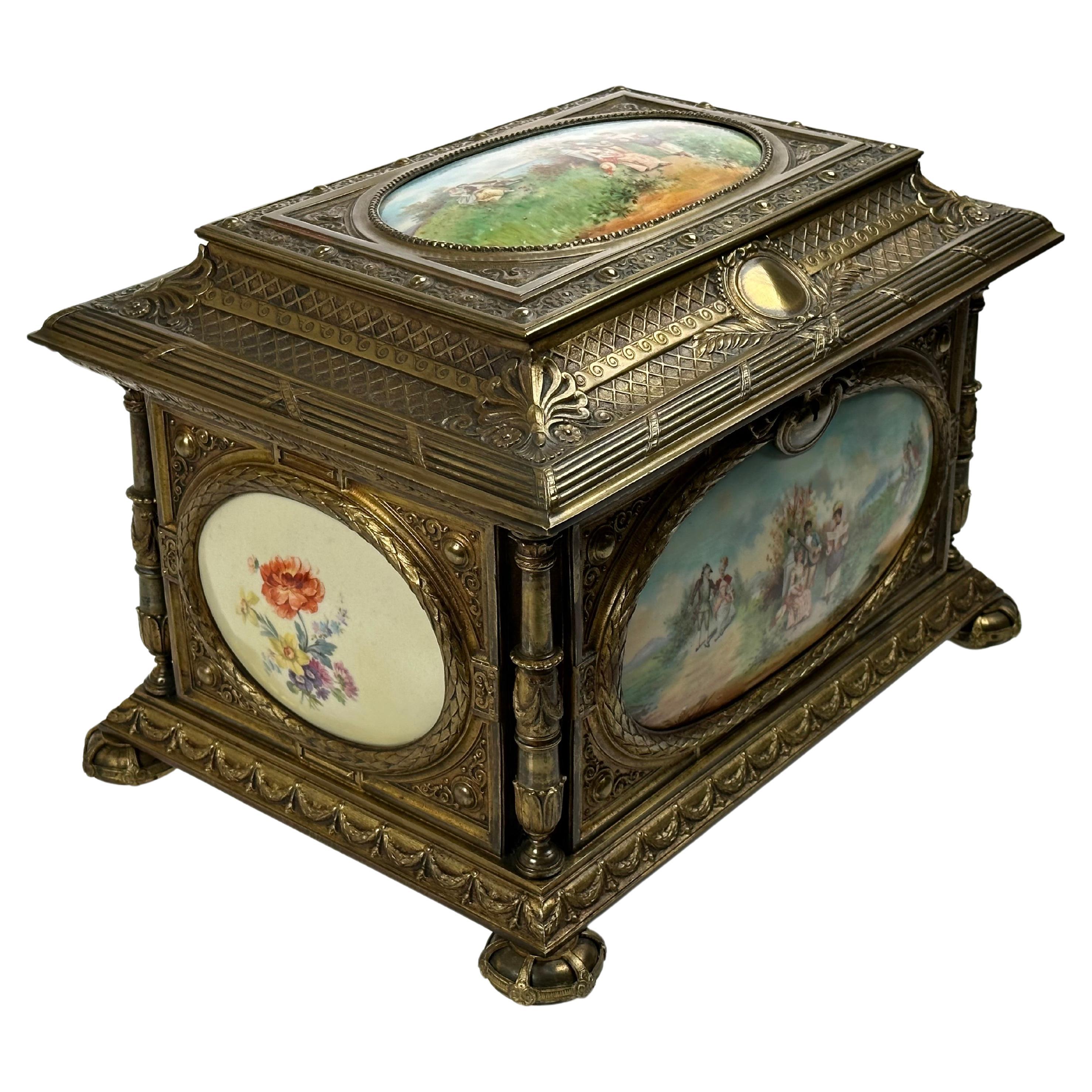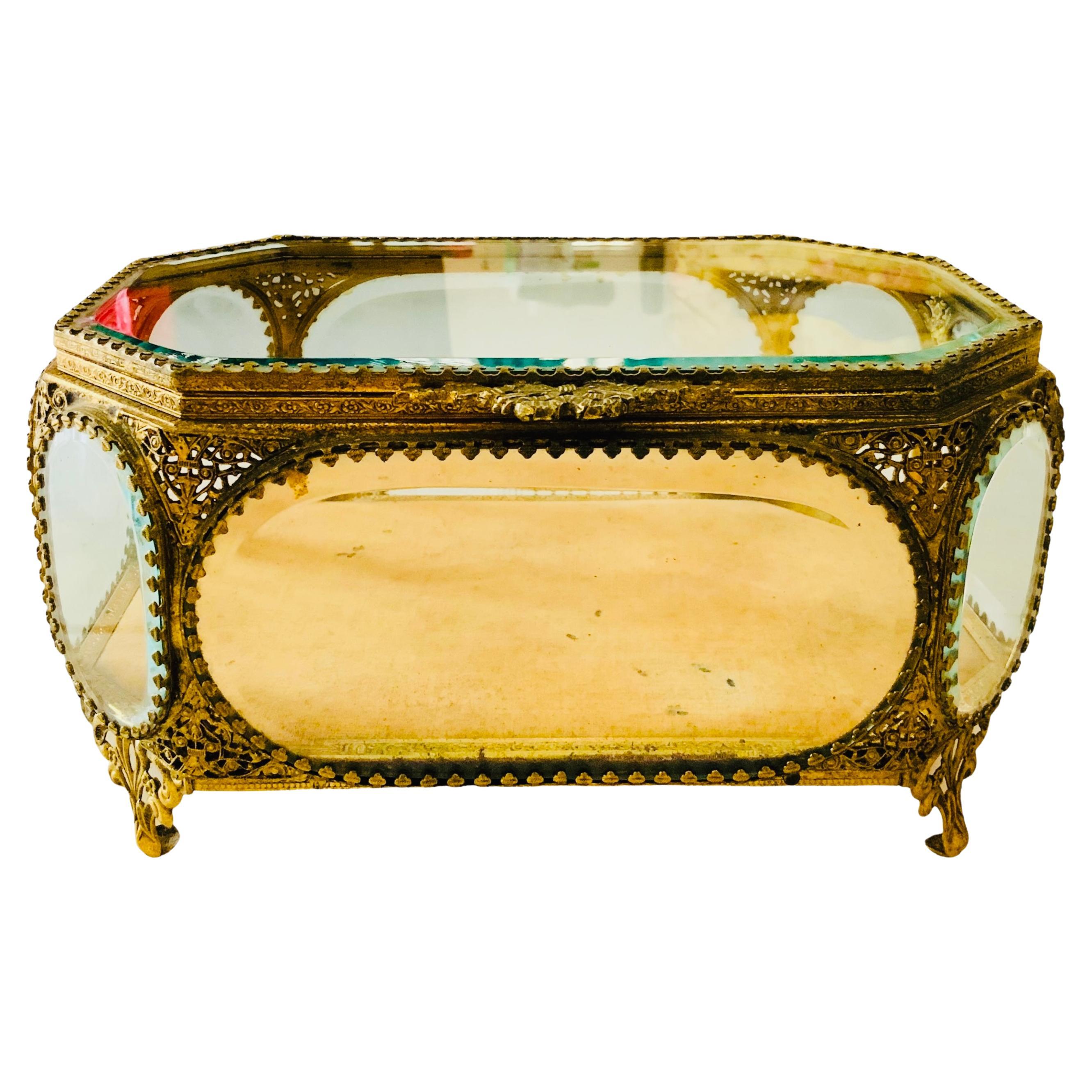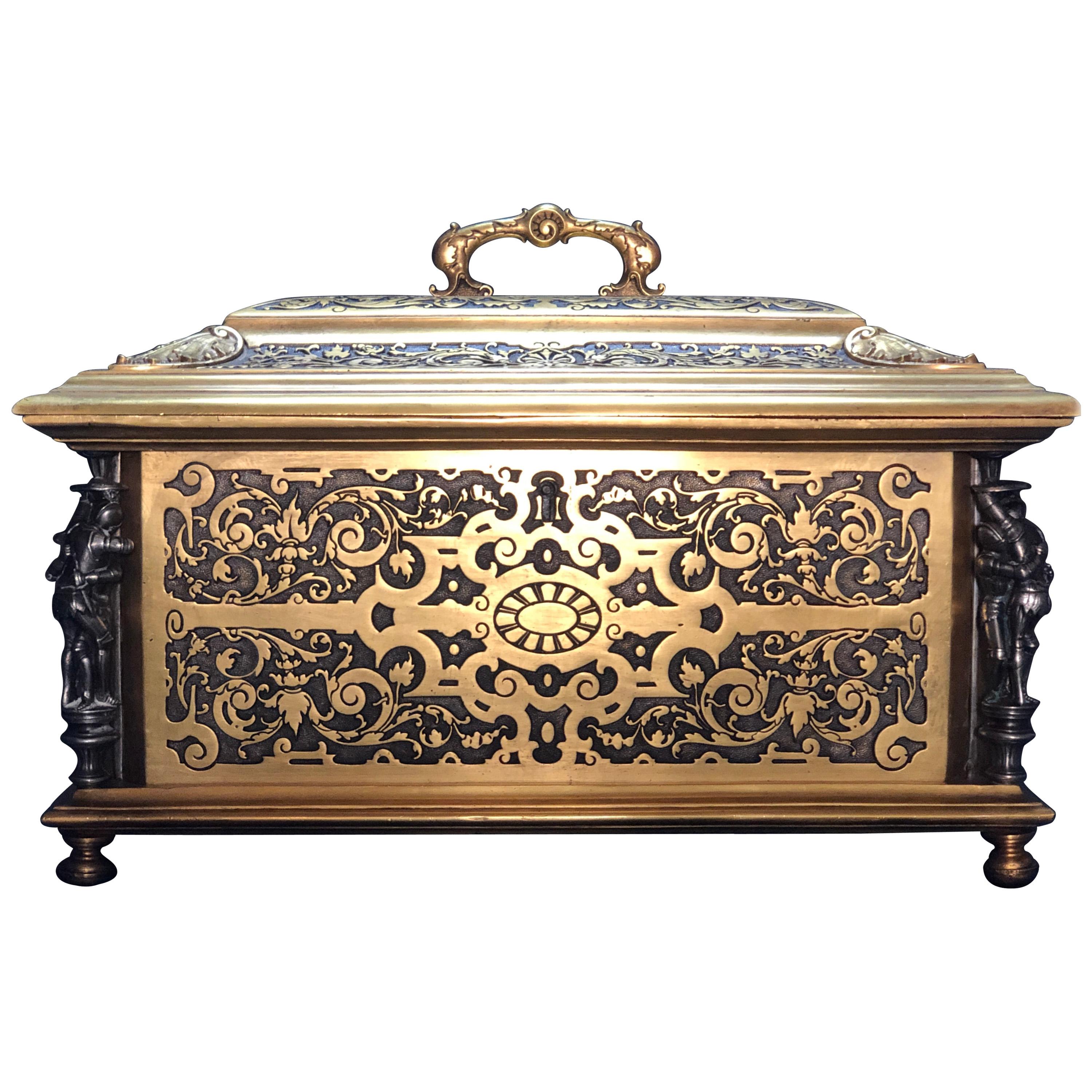Items Similar to Rare Antique Italian Jewelry Box Casket with Gilt Bronze Lockplate & Hasp Attrib
Want more images or videos?
Request additional images or videos from the seller
1 of 8
Rare Antique Italian Jewelry Box Casket with Gilt Bronze Lockplate & Hasp Attrib
About the Item
A scarce antique Italian fall-front jewelry box with lockplate and hasp attributed to Jacopo and Lodovico del Duca.
Lockplate and Hasp designed circa 1570, date of manufacture unknown, attributed to the late 16th century Roman foundry of Jacopo (c. 1520-1604) and Ludovico (fl. 1551-1601) del Duca.
The rectangular drop-front box casket, circa 1880, signed L'PUPLET, features an earlier finely cast gilt bronze lock plate with a coat-of-arms and hasp, mounted on drop-front chest of drawers form box covered in embossed and gilded paper, having fall-front panel opening to reveal three interior drawers, all lined in red velvet.
The wallpaper covering the box's exterior features bamboo, birds, and flowers in the Japanesque taste (orientalist) popular in Europe in the 1870s and 1880. To the interior of the fall front is a circular stamp with the name of the workshop or store (possibly L'PUPLET) somewhat obscured, and the city "Burxelles" indicating that the box was likely made or retailed in that city in the late 19th century.
Marks to box:
L'PUPLET, BRUXELLES
Inscription:
13, 14, 15 (Interior drawers inscribed on the verso of their backboards in script from top to bottom, respectively)
Provenance / Acquisition:
The origin of the elaborate lockplate with hasp on the front of the piece is more intriguing. At least 76 lockplates of this design have been recorded in major museums, private collections, and in the antiques trade across the Western World. For example, lockplates of this pattern are in the collections of the Rijksmuseum in Amsterdam, the State Museum of Prussian Cultural Heritage in Berlin, the Museum Cicico in Bologna, The Museum of Fine Arts in Boston, the Dallas Museum of Art in Texas, the Victoria & Albert Museum in London, the Museo di Palazzo Venezia in Rome, the State Hermitage Museum in St. Petersburg, and the National Gallery of Art in Washington, DC.[1]
Specialists in Renaissance bronzes, especially Charles Avery and Lukas Madersbacher, have assembled robust inventories of such pieces and have attempted to decode the late Mannerist iconography, family coat-of-arms, and use of these amazing objects.[2] Madersbacker published a study in 2021 where he argues that the female figure on the hasp is that of Dovizia, a kind of 'house goddess' guaranteeing prosperity and fertility; and that this image was likely based on a prototype from the Italian Renaissance sculpture Donatello. The male-female pair of reclining, nude warriors who have cast off their armor above have not yet been identified, but according to Madersbacker fit well into an iconographic tradition of such pairings.[3]
Originally the use of such lockplates in the late 16th century was to ornament and secure travel chests in which wealthy individuals could transport their personal belongings as they moved between homes and other locations.[4] Many of the lockplates include the coats-of-arms of wealthy Italian families who owned them, and it is believed that a significant number of examples were made to celebrate marriages between powerful families. Others appear to have simply been made as luxury items to adorn and identify the owners travel chests. The coat-of-arms on the hasp is believed to be that of the Gras-Préville family of Italy and southern France.[5]
The exact dating and creator of this lockplate design has eluded scholars, but Madersbacker, building on the earlier work by Avery, argues that the earliest known example was made to commemorate a marriage that took place in Rome in 1569 and that such lockpates continued to be made in significant quantities until at least c. 1600.[6] He further postulates that this time period, along with the fact that most of the families who commissioned chests with this lockplate design lived in or were connected to Rome, suggest it is possible that they were produced in the shop of brothers Jacopo (c. 1520-1604) and Lodovico del Duca (active 1551-1601). Jacopo was well known at the time as a sculptor and architect who is most remembered for assisting Michelangelo with projects in Rome, including the sculpture and construction of the tomb of Pope Julius II.[7]
Several of these lockplates with hasps survive on their original domed-topped chests, but the vast majority do not. Rather, they were retained once the usefulness of the chests was over and subsequently introduced into the European antiques trade in the 19th century.[8] Furthermore, it is believed that later examples were made although the chronology for this work has not been delineated. This effort is hampered by the fact that some examples were never gilded or have lost their gilding and that there are variations in size between examples.[9]
While more work has yet to be done on these intriguing and beautiful objects, the original design remains one of the most beautiful and prolific of Renaissance Italy.
Drop-front caskets of this kind probably first appeared in Germany around the middle of the 16th century and soon became popular in Italy, the Iberian peninsula and elsewhere. Having various names depending on origin, time period, and intended use, they were frequently used by merchants as a writing box during travel and trade, coffer storing important documents and valuables, jewel casket, table box, etc...
1. Charles Avery, "Fontainebleau, Milan, or Rome?: A Mannerist Bronze Lockplate and Hasp", Studies in the History of Art, vol. 2, Symposium Papers IX: Italian Plaquettes (Washington, DC: National Gallery of Art, 1989), pp. 291-305
2. Charles Avery, "Fontainebleau, Milan, or Rome? A Mannerist Bronze Lockplate and Hasp" Studies in Italian Sculpture (London: 2001), pp. 339-86 (this is an extended version of his 1989 article of the same title); and Lukas Madersbacher, "Armorial Lockplates: A Story of Success in Renaissance Rome", The Rijksmuseum Bulletin, vol. 69, no. 4 (Amsterdam: Rijksmuseum, 2021), pp. 303-303-321.
3. Madersbacher, pp. 303-304.
4. Ibid., p. 305.
5. For an example with the same coat-of-arms see, Charles L. Venable, Decorative Arts Highlights from the Wendy and Emery Reves Collection (Dallas: Dallas Museum of Art, 1995), p. 15.
6. Madersbacher, pp. 317-318.
7. For a very brief encapsulation of the artists life and work, see: the Wikipedia entry for "Giacomo del Duca".
8. For images of such surviving chests, see Madersbacher, p. 305.
9. Based on Avery's inventory the majority of these lockplates are about 18 cm. square, with larger and smaller variants on either side of that measurement. For one of the smallest examples, which some believe to be a 19th-century example after the original, see Christie's Auction Catalogue (London, 31 Nov. 2010), lot 423.
Acquired from highly reputable auction house Heritage Auctions, Dallas, Texas. Catalog: 2022 June Fine Furniture & Decorative Arts Signature Auction #8085.
Dimensions: (approx)
8.25" High, 7.5" Wide, 6" Deep
Condition Report:
Overall a superb example. attractive appearance; structurally sound; beautifully aged patina over the whole; wear consistent with age, losses to veneer; scattered professional restoration, especially to interior drawers.
- Dimensions:Height: 8.25 in (20.96 cm)Width: 7.5 in (19.05 cm)Depth: 6 in (15.24 cm)
- Materials and Techniques:
- Period:
- Date of Manufacture:circa 1880
- Condition:Repaired: Scattered professional restoration, especially to interior drawers. Wear consistent with age and use. Minor losses. Overall a superb example. attractive appearance; structurally sound; beautifully aged patina over the whole; wear consistent with age, losses to veneer; scattered professional restoration, especially to interior drawers.
- Seller Location:Forney, TX
- Reference Number:1stDibs: LU5977229376242
About the Seller
4.8
Platinum Seller
These expertly vetted sellers are 1stDibs' most experienced sellers and are rated highest by our customers.
Established in 2013
1stDibs seller since 2021
200 sales on 1stDibs
Typical response time: <1 hour
- ShippingRetrieving quote...Ships From: Forney, TX
- Return PolicyA return for this item may be initiated within 7 days of delivery.
More From This SellerView All
- Petite Antique French Neoclassical Gilt Bronze Jewel CasketLocated in Forney, TXA fine diminutive French Neoclassical ormolu gilded metal jewelry casket. Born around the turn of the 18th/19th century, the exceptionally executed petite masterpiece features a rectangular chest shape with hinged dome lid, opening to the original worn ivory silk-lined interior, when removed revealing mark "XVII" (c.1785-1795) to the bottom of the interior. The top, front, sides and back magnificently decorated in ornate repousse ornamentation, classical masks, fruit filled urns flanked by cherubs...Category
Antique 19th Century Neoclassical Jewelry Boxes
MaterialsMetal, Ormolu
- Antique Victorian Enameled Blue Opaline Milk Glass Dresser Box Jewelry CasketBy CF MonroeLocated in Forney, TXBeautiful antique Victorian era enameled blue opaline milk glass dresser box, (jewel casket - trinket case - decorative table box), late 19th centur...Category
Antique Late 19th Century Unknown Victorian Decorative Boxes
MaterialsOpaline Glass
- Large Antique South Asian Colonial Carved Camphor Wood Table Box Jewelry CasketLocated in Forney, TXA scarce antique circa 1900 South Asian hand carved wooden decorative table box / jewel casket. Hand-crafted in the early 20th century, likely British Ceylon (present day Sri Lanka)...Category
Early 20th Century South Asian Jewelry Boxes
MaterialsWood
- Fine Antique English Toulmin & Gale Attrib Madagascar Ebony Stationary BoxBy Toulmin & GaleLocated in Forney, TXA stunning very fine quality antique English stationary box in striking exotic hardwood coromandel / madagascar ebony. circa 1880 Exquisitely hand-crafted in England in the 19th cen...Category
Antique 19th Century English Victorian Decorative Boxes
MaterialsBrass
- John Richard Attrib Black Lacquered Sun Rise Inlaid Table BoxBy John RichardLocated in Forney, TXA stunning contemporary black lacquered multi-ray inlaid decorative table box attributed to luxury designer John Richard. This glamorous Art Deco style box...Category
21st Century and Contemporary Art Deco Decorative Boxes
MaterialsResin
- Antique English Mahogany Table Box With Divided InteriorLocated in Forney, TXA high quality mahogany table box from the early 20th century. English Edwardian period, rectangular chest form with fine quality brass hinged lid, opening to reveal a divided inte...Category
Early 20th Century English Edwardian Decorative Boxes
MaterialsBrass
You May Also Like
- Antique Gilt Bronze Decorative Jewelry Box or Casket with Floral DecorationLocated in Hamilton, OntarioThis antique gilt bronze decorative or jewelry box is unsigned, but presumed to have originated from France and dates to approximately 1900 and done in a Renaissance Revival style. T...Category
Early 20th Century French Renaissance Revival Jewelry Boxes
MaterialsBronze
- A French Gilt Bronze Jewelry Casket with Red InteriorLocated in Los Angeles, CACirca 1900 Origin: Paris Signed: A. MARIONETT Dimensions: H: 3.5" W: 9 " Open: 10"Category
Antique Early 19th Century French Jewelry Boxes
- Chinoiserie Gilt Bronze Champlevé Enamel Casket BoxLocated in New York, NYUnusual and Ornate Gilt Bronze Champlevé Enamel Lidded Casket. After a bamboo box, this champlevé box contains five enameled faces with gilt bronze bamb...Category
Antique 19th Century Chinoiserie Decorative Boxes
MaterialsBronze, Enamel
- A Large French Antique Sevres Style Porcelain & Gilt Bronze Box CasketBy Manufacture Nationale de SèvresLocated in Los Angeles, CAAdorned with five painted panels depicting delicate floral motifs and classical scenes, this piece showcases the hallmark elegance and artistry of Sevres porcelain. Sevres porcelain...Category
Antique Late 19th Century French Jewelry Boxes
MaterialsBronze
- Victorian Style Gilt Metal Octagonal Shaped Casket/Jewelry BoxLocated in Guaynabo, PRThis is a large gilt metal octagonal shaped casket/jewelry box. Their beveled glass is framed with a gilt garland of tiny shamrocks and their corners are decorated with a filigree pa...Category
Mid-20th Century Victorian Jewelry Boxes
MaterialsMetal
- Large Gilt and Silvered Bronze Jewel Box/CasketLocated in Norwood, NJFrench 19th century large gilt and silvered bronze table box. Finely cast Renaissance Revival gilt and silvered bronze jewelry box with tufted velvet interior lining. Four corners wi...Category
Antique Late 19th Century French Renaissance Revival Decorative Boxes
MaterialsBronze
Recently Viewed
View AllMore Ways To Browse
Italian Jewlry
Box And Papers
Jewelry From Italy
Jewellery From Italy
Italian Gold Box
Jewelry Box Italy
Jewellery Box Italian
All Antique Jewelry
Fine Jewelry Box
Fine Jewelry Boxes
Antique Jewellery Used
Antique Jewelry Used
Antique Jewelry Marks
Antique Jewellery Marks
Antique Jewelry Mark
Small Jewellery Box
Small Jewelry Box
Antique Jewlry Boxes
